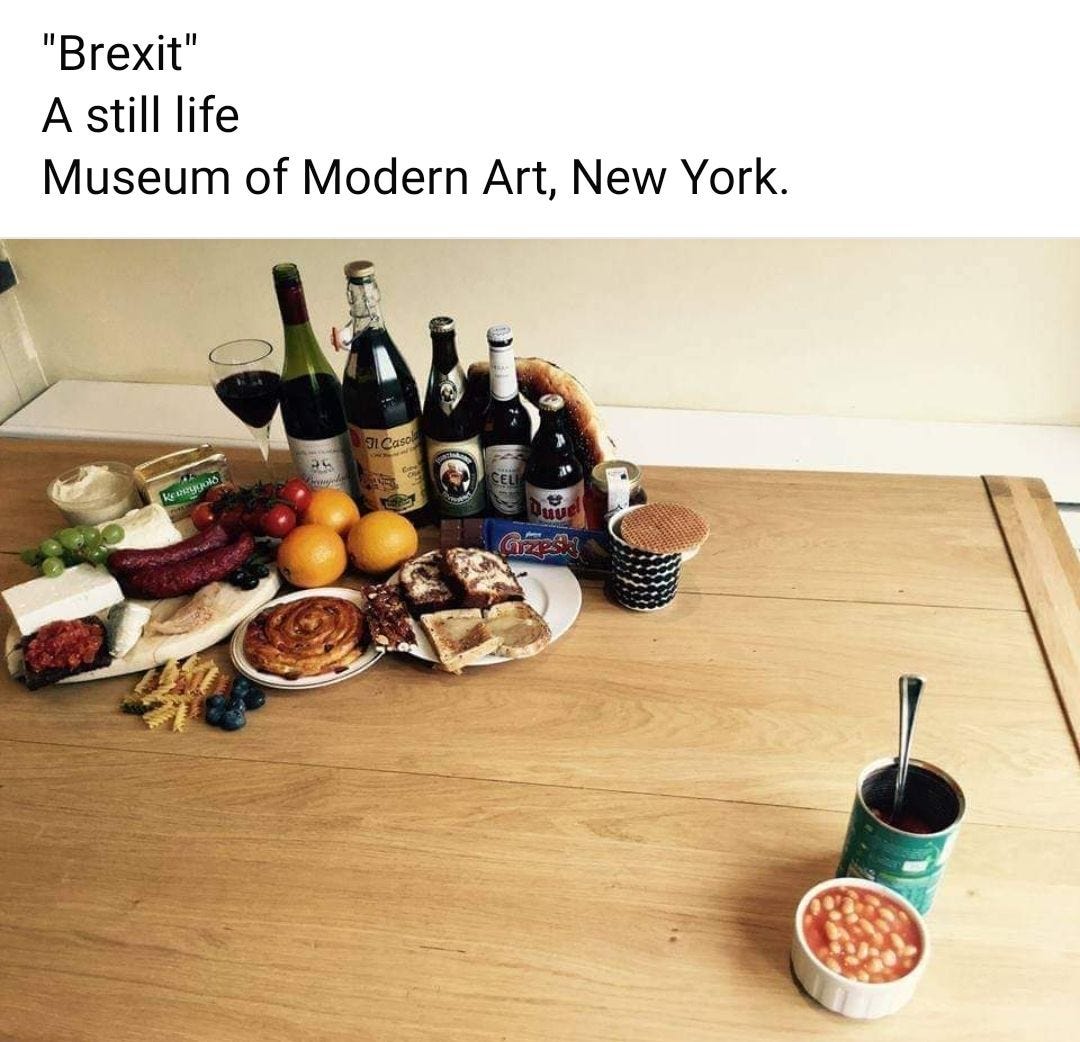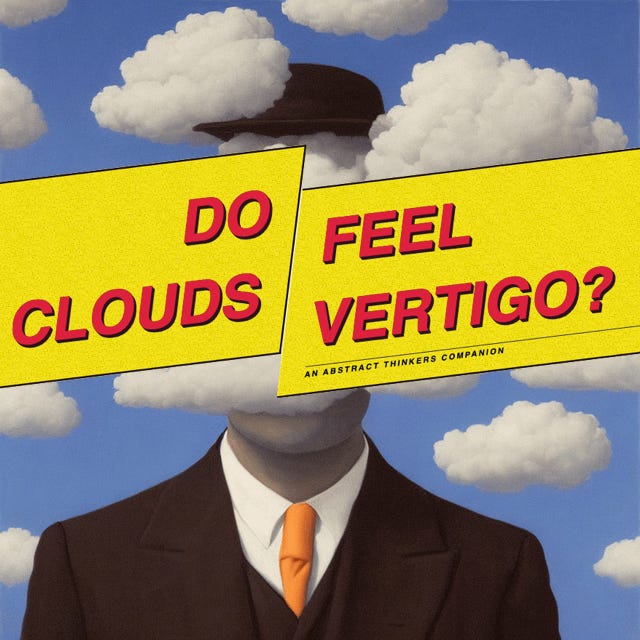We're not ready for the future
Wednesday Whatnot #2 - Tavares Strachan. Questioning storytelling. Crises. The disruption nexus. Civil war?
This morning I was uninspired. In my to-do list sat a new task. Write a short cultural column nobody is going to comment. I felt overwhelme.
So, I asked ChatGPT what could I talk about. The monster suggested a heavy dose of boring, or at least peacefully mainstream topics: Ai Weiwei and Banksy, Teju Cole and Chimamanda Ngozi Adichie, Greta Thunberg and Black Lives Matter.
So I challenged the AI: “don't be banal. don't go for the most publicly relevant and common names. many of those suggestions are too mainstream to be interesting to the well informed public. use your best judgement to scout for quirks, oddities, uncommon features”.
wednesday whatnots are the new creative nosedives of do clouds feel vertigo: we leave the abstract stratosphere to plunge into the shared cultural now 🔥
Suddenly, the names became more interesting. They felt original and special. Their oddity was just the right kind. They were rebels. Their work’s strength was being interdisciplinary. It was the work of artists, architects and writer who drew from physics, biology or computer engineering. Just my kind of rabbit holes.
We begin our plunge from the ideas’ stratosphere very fast: questioning the relationship with established truths.
Tavares Strachan
"My work questions the nature of our relationship to the truth. It is really hard to be human without having a relationship to storytelling. Storytelling has been central to every significant movement spanning the history of art. Culture is formed as a result of storytelling, which encompasses all the things we try to hold onto and share with the next generation. So, what happens when historical narratives are false? What do we do with that?" — Tavares Stratchan
The Bahamian artist Strachan deals in his work with cultural invisibility, community, and the histories of underrepresented peoples. His collages show fragmented identities and looming threats. In December, he recasted Leonardo’s Last Supper at the Royal Academy (Guardian) to send a message about colonial storytelling. His seat? Judas. His 2022 collection “The Awakening” is a testament to rewrite racial narratives.

Today in London there’s his new solo exhibition “There Is Light Somewhere,” which will be available from 18 June to 1 September 2024 at the Hayward Gallery. It’s described as a playful ride to rediscover hidden cultures and stories. Enjoy!
If you want to see more of this writing happening, come say hi and suggest someone you would like to feature next.
👾 unexplored connections
Meanwhile…
The Disruption Nexus (Aeon). The cultural cycle is the midst of its own disruption nexus. “Polycrisis. Metacrisis. Omnicrisis. Permacrisis. Call it as you like” - political philosopher Roman Krznaric author of forthcoming History for Tomorrow doesn’t believe we need new definitions. In his article and latest book, he decides to retrace the history and significance of a well-travelled concept: crisis.
None of the ideas feel new, but his overview is broad and knowledgeable. The aim? To explore what might bring about a “surge of political will, that elusive ingredient of change”… The picture he draws is linear:
There’s the Crisis. A political, economic, technological or ecological rupture, which destabilises the system.
Ideas. Crises makes new ideas relevant. Narrative inform worldviews, which reshape policies.
Movements. Ideas inspire movements. Activism challenges the power holders. Movements in turn amplify the crisis.
In today’s world, the interplay of “political movements” sounds retrò. Like something that belongs to the menu of a XX century French café, to be enjoyed with a deep red wine. Political conflict now does not belong to traditional civil and urban political actors and Western elected liberal governments. It’s OnlyFans models selling their nudes and Solopreneurs selling their playbooks; and hordes of Twitter (X) trolls fighting against the Threads’ bots.
The cultural space is saturated with noise. Fragmentation has become ineludible. Side question: what do both sides snack on planning the next social upheaval?
Oddly enough, there’s someone who seems to be wondering about these same topics at the same time: it is billionaire hedge-funder Ray Dalio.
In The Coming of Great Conflict (TIME) or Pick A Side And Fight For It, Keep Your Head Down, Or Flee, he wonders where are we on the cycle of internal disorders. What captures the attention of his long read is not the credit cycle (5.33% EFFR), technological advances (AI), or the external conflicts (Ukraine). All of the stories that are absorbing daily the attention of Bloomberg commentators are out of the picture. The conflict he picks to candidly explore is radically different: it’s a US civil war.
I won’t deny it. I felt some uneasiness reading that Dalio believes we are sitting at the brink of a civil war and people may be forced to make a choice between fight or fly. It’s like storm clouds are building over the highway of the liberal democracies’ future.
It seems to me that if Biden wins, it is likely that Trump and those on the hard right who he represents won't accept the leadership of Biden and the Democratic Party, and that if Trump wins, those on the hard left won't accept Trump's leadership and tactics. What happens next depends on the strength of the legal system, with those on each side seemingly more willing to fight its judgments than abide by them if they don’t get what they want. For these reasons, it seems to me that there is a higher than 50 percent chance that democracy as we know it won't run smoothly through the election and beyond, […]
The prediction seems bold. The model yet is forceful and simple. Along the two-sided distrust, there are inadequate financial conditions, debt and a toxic mix of large income, wealth, and values gaps within the system. All it takes is a single external shock and we might experience some scary edges of civil unrest. What’s the next Capitol Hill or Stop The Count going to be like? What will be the magnitude and frequency of such episodes?
I agree that this is the biggest currently underestimated risk to US equities. Markets today are calm and exuberant. The S&P 500 seems like a never ending, self-fulfilling prophecy of good vibes for investors. US country risk is not far from historical lows, for good reasons: productivity is the highest and yet growing (AI!)
This is why it is our job to question with Dalio and any serious investor: what might instead go wrong? In the next thirty years, can we imagine the US Federal unity threatened (peacefully or otherwise)? Just a hint of such a possibility would spread panic waves across the pond. Watch out for the internal order-chaos balance.

In my view, Brexit represented the latest and greatest civil disruption to a political project. In our last decade, we haven’t seen any other internal reconfiguration. We rebounded okay. After all, many would point out that rewriting inter-governmental agreements after a referendum cannot be compared to civil unrest. Yet, I feel the magnitude of change it brought about is similar. It was a narrow vote that hijacked the trajectory of a nation state and the civil liberties of millions…
What other futures may hold in store for us a fat can of baked beans?
D.
Don’t: stress out and become overly concerned. Do: hit the Like button, do your own research, explore faraway narratives and forward this to a family member, friend or colleague who might benefit from the read!






